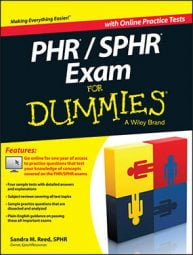These exams test you on what you should know to be a proficient human resources professional. You may begin to study before you're approved to test, so the application process often runs concurrent with your study efforts. Keep this cheat sheet handy for reminders on how to schedule your exam, information about what to do with your score report, and how to begin to recertify your credential.
 © tulpahn / Shutterstock.com
© tulpahn / Shutterstock.comCompleting the application to take the PHR or SPHR exam
The PHR and SPHR exams are experience-based; therefore, it stands to reason that the application process will begin with a review of your HR work history. Start by creating an online account with the Human Resources Certification Institute (HRCI). You also will log in your recertification credit activities after you’ve been successful taking the exam at this account. (Keep track of your password.)
Don’t wait until the last minute to complete the application. Submit you application early in the exam window to avoid delays or late application fees.
After your account is established, you can begin the online application process. Make sure the name on your application matches the name on your government-issued ID. You also need to use approved position title codes as you outline your work experience. Find the complete list at www.hrci.org. If you have a compatible title, such as operations manager or executive, you can use code 999 and upload a current job description to help HRCI determine your exam eligibility. Submit your payment along with the application and wait to receive your authorization-to-test (ATT) email.
Think about the two main requirements of completing Form I-9 in the HR world. The form’s purpose is two-fold: verify identity and verify eligibility to work in the United States. The goal of HRCI’s application process is similar. HRCI needs to know who you are and that you meet the minimum requirements. The verification continues at the testing center. The name on your application must match the name on your unexpired, government-issued ID.
Scheduling the PHR or SPHR exam
After you apply to take the PHR or SPHR Exam and your application has been approved and you have received the authorization-to-test (ATT) email, you’re now cleared to schedule when you want to take the exam. Both the PHR and SPHR exams are administered through Prometric.
The receipt page of your application payment will have a link to the Prometric website. Check out the site for this information as well as other fascinating insights to preparing for exam day.
Receiving results after you've taken the PHR or SPHR exam
Back in the day, exam takers had to wait up to six weeks for results after they took the PHR or SPHR Exam, but with computerized testing, you fortunately get a preliminary pass or fail right after you complete the exam and subsequent survey.
It’s recommended that you wait to publish your exam success until you receive the certification in the mail. For this reason, make sure you keep your HRCI account updated with your most current mailing address.
If you didn’t pass, you’ll also receive a report that shows your functional areas scores so you can see how you did in each area. You can use this information to identify in which area you need additional preparation for a successful second attempt. Don’t let an initial fail derail you from your goal. Look back at where you started and how far you came as the result of your studying efforts and apply the test results to rounding out your knowledge base in human resources.
If you passed, you may now officially put the initials next to your name on professional communications. Keep in mind that even though they’re acronyms, the initials are presented without periods as such: Sandra M. Reed, SPHR.
Recertifying your PHR or SPHR credentials
After you receive your PHR or SPHR certification (which means you passed the PHR or SPHR exam), your work isn’t finished. You’re required to keep up your certification. You’re granted three years to earn the 60 recertification credit hours necessary to maintain your credential, so it’s never too early to begin thinking about the process.
Each certification credit is worth one hour of an approved activity. Log in to your HRCI account and get familiar with how to log activities in your profile. A few limits cap the amount of recertification credits you can earn.
Following, is a list of the different types of activities that earn you recertification credits, along with a short description and maximum number of hours allowed.
- Continuing education units (CEU): You may earn recertification CEUs, or credits, by taking formal or informal classes that inform you of relevant issues in HR today. The classes may include taking business courses at the local junior college, participating in a webinar, completing an eLearning course, or attending conferences. CEUs have no maximum, so you could conceivably earn all 60 credits by this activity.
- Instruction: Teaching or training an HR-related topic is an excellent way to jump-start your recertification process. It maxes out at 20 credits, which translates into 20 hours in the classroom. Over a three-year period, that’s 6.5 hours per year. Not too difficult, depending on your role at work.
- On-the-job experience: Also capped at 20 hours, on-the-job training consists of activities that you do in your day-to-day work. It may include creating a company handbook or putting together an HR budget. Note that these credit hours will be approved only if it’s a new job responsibility, which HRCI classifies as first-time work experience.
- Research/Publishing: Also at the 20 hours maximum is research and publishing. Activities in this category include writing an HR fact-based blog or co-authoring an HR text. Consider also writing an article for your local HR association’s newsletter.
- HR leadership roles: Leadership is an important part of the evolution of the HR professional, so HRCI awards up to 10 hours in the leadership category. These hours may be approved for recertification credits if you take on a leadership role within the HR community outside of your organization. This may include participating in lobbying efforts, chairing a committee, or sitting on the board of your local HR association.
- Professional membership: Probably the easiest 10 hours you can earn is in this category of professional membership. Note, however, that your membership must be on a national (not local) scale in order to be counted. Three credit hours are awarded for a year of membership.
As with all things PHR- or SPHR-related, the best resource for questions is the HRCI, which has an excellent free publication titled Recertification Handbook that you may download. This handbook goes into rich detail of the ways to select recertification activities and examples of what will be approved so you can avoid surprises when it’s time to renew.
Don’t wait until your certification is about to expire to try and organize/log your credit hours. Calendar it for the first of each month to jump online and log your activities for the month. This way, when it’s time to recertify, your application will be near completion. If that’s too daunting, send yourself an email with the relevant information and store it in a digital folder. This way, all of the certificates or classroom information is housed in one folder for easy access when it’s time to recertify. Of course, if keeping track of your recertification credits seems like too much, you could always recertify by taking the exam again.
Recertification activities don’t necessarily have to be preapproved programs. Although inconvenient, you may alternatively upload the details of a specific program, job, or training activity with a description and documentation robust enough to withstand future scrutiny should the activity be audited.

